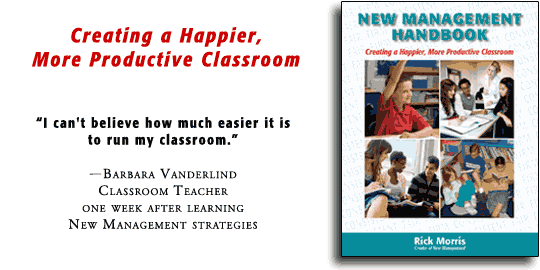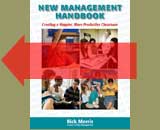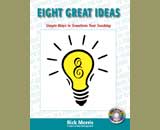

NOTE: This book is no longer available
in printed form.
12-09-2019
However, an updated version of the New Management Handbook is one of the four books that can be found in The Big Book.
![]()
Introduction (from the book)
It wasn't easy to write.
In fact, I started working on this book way back in March, 1986. I had just finished teaching my first New Management class to a group of 13 teachers. I was excited by the results of that experience and wanted to put into writing what we had covered. (I still have the original note paper I scribbled on while sitting at the local coffee house. It's framed and hanging on the wall of my office.)

Well, after banging out about 30 pages, I became overwhelmed by the enormity of the task. And since the workshops were becoming more popular, I had less time for writing. Also, I had come to realize that verbalizing my teaching philosophy and classroom techniques during these workshops was helping me to refine and clarify them. I felt that this teaching experience would actually enable me to write a better book.
So, I set aside the handbook project and concentrated on the workshops instead. Having done that for over a decade, it seemed that the time was right to produce the written version of the basic New Management workshop.
I'm glad I waited. By not writing the book in '86, I've been able to include all of the experience and insight gained from conducting workshops. Additionally, the feedback and input offered by teachers who have attended New Management staff development sessions have been incorporated into my writing. As a result of my editorial hiatus, this handbook will actually be more complete and, thus, more useful.
Nonetheless, I didn't want to wait any longer. Judging from the enthusiastic comments shared by the thousands of teachers using the New Management system, I felt that there was a real need for the ideas espoused in this book.
Whether you are a first year teacher just starting out, or a seasoned veteran with years of classroom experience, you'll find ideas that will increase your effectiveness and boost the achievement of your students. The New Management techniques you'll read about are not only simple but work for students as well as they do for teachers. The entire system will help you bring about a sense of order, structure, and accomplishment to your classroom.
All of that in one little book?
How is that possible?
What makes the whole thing work the way it does?
Why do teachers say they'll never go back to the old way of running their classrooms?
What's the secret to New Management's success?
Here's the secret: Number your students.
That's it. The cat is now out of the bag.
Thirty-one sixth grade students in your class this year?
Number them from 1 to 31.Twenty-two kindergarteners cavorting about your room?
Number them from 1 to 22.Twenty-nine hormone-crazed ninth graders trying to keep
their hands off of each other in your fourth period math class?
You guessed it. Number them from 1 to 29.
Each student in your room will receive a number. The first student will be 1 and the last will be n, n representing the total number of students in your class.
Earthshaking? No.
Mindboggling? Not really.
So what's the big deal?
By taking this one simple step, i.e., numbering your students, you will be setting the stage for a major change in how you'll deal with this year's mountain of paperwork and class-related responsibilities. And, with the tools I've created to take advantage of the numbering concept, you won't be the only one attempting to take care of business. You'll have a whole classroom full of eager helpers.
Numbering your students is a tool you, and your students, will use to better monitor, manage, and account for your class and its progress. By having your students add a number to their class identity--which, up to this point in the history of education, has usually consisted of their first and last names--you will be providing yourself with an amazingly flexible framework upon which to build a system for classroom management. The numbers provide the underlying foundation, the very backbone, for the entire New Management system.
This book, then, is my attempt to share the success of that system, and I thank you for purchasing it. More importantly, though, I applaud your willingness to use the New Management techniques contained in these 10 simple lessons.
It's not an easy thing trying new ideas. It requires that you stretch and take risks. It means that you become a student yourself. This role reversal, though, is one of the best things you can do to improve your teaching. As John Cotton Dana so elegantly phrased it, "Who dares to teach must never cease to learn." A teacher with a desire to grow and develop is a teacher worthy of the name.
As I've always maintained, the greatest force we have in education is the individual teacher. It's not a governance team or a school advisory committee. It's neither the local school board nor some education agenda coming from Washington, D.C. Our strongest force in education is the classroom teacher dedicated to excellence. It's a caring, effective person who can bring out the best in a group of students. And if this book can help fellow educators bring out the best in the kids with whom they spend so much time, then it will have served its purpose.
Rick Morris
San Diego, California
January 1, 2007
Post Script
New Management is not meant to be portrayed as a rigid, chiseled-in-stone, do-it-this-way-or-else kind of program. On the contrary, the strength of its design, what gives it such wide appeal and applicability, is that it's a very open-ended system. In fact, a great deal of the success that teachers have experienced is that they freely bent the rules to make things work. They didn't limit themselves to just what they read. Instead, they picked up basic New Management techniques and then set off in slightly different, yet equally successful, directions.
Consequently, descriptions of how I do things are offered merely to give you clear, specific examples of how it could be done, not how it has to be done. So, be creative with the ideas presented in this book. If an idea doesn't work properly for you and your students, see if you can change it so that it does work. After all, that's how New Management has grown to be what it is today.
You may find, though, that some of the ideas are not producing results as quickly as you had hoped. It's either taking too long for your students to become adept at the technique or you keep forgetting to use the idea itself. Whenever you feel that way, just relax and practice patience. Remind yourself that education is a process. It's more than just a series of days; it's a continuum in which the whole is greater than the sum of the parts. Sometimes new ideas take a bit of time before they bear fruit; but, given the proper time and a nuturing touch, bear fruit they will. What you wouldn't want to do is give up on an idea before it had been given a fair chance to succeed.
Nonetheless, there are times when, in spite of your best efforts, you'll find that you need to stop using one of the techniques because it's just not working. If that's the case, drop it and move on. As my grandfather taught me years ago, "If the horse you're riding on dies, get off. It won't do you any good to adjust the saddle or change the bit." It's very possible that you'll be able to bring back the idea later on in the year and achieve more success.
So, I encourage you to:
Be creative.
Be inventive.
Mess around with this stuff.
You never know where you might end up if you just ditch the map and set out on your own.
After all, there are many paths to excellence.
![]()
Look Inside the Book
For a more complete picture of the book and its contents, just click here.




